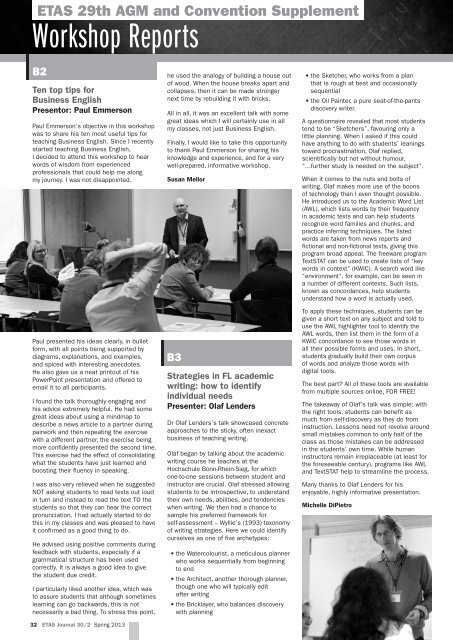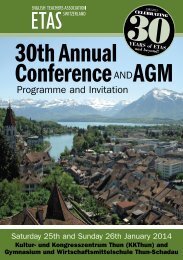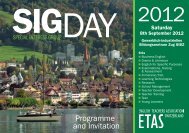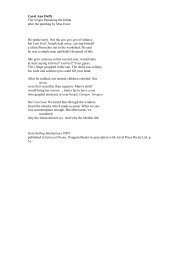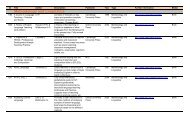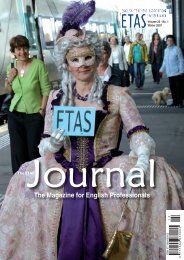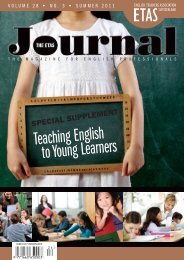Spring Journal 2013 - English Teachers Association of Switzerland
Spring Journal 2013 - English Teachers Association of Switzerland
Spring Journal 2013 - English Teachers Association of Switzerland
You also want an ePaper? Increase the reach of your titles
YUMPU automatically turns print PDFs into web optimized ePapers that Google loves.
ETAS 29th AGM and Convention SupplementWorkshop ReportsB2Ten top tips forBusiness <strong>English</strong>Presentor: Paul EmmersonPaul Emmerson’s objective in this workshopwas to share his ten most useful tips forteaching Business <strong>English</strong>. Since I recentlystarted teaching Business <strong>English</strong>,I decided to attend this workshop to hearwords <strong>of</strong> wisdom from experiencedpr<strong>of</strong>essionals that could help me alongmy journey. I was not disappointed.Paul presented his ideas clearly, in bulletform, with all points being supported bydiagrams, explanations, and examples,and spiced with interesting anecdotes.He also gave us a neat printout <strong>of</strong> hisPowerPoint presentation and <strong>of</strong>fered toemail it to all participants.I found the talk thoroughly engaging andhis advice extremely helpful. He had somegreat ideas about using a mindmap todescribe a news article to a partner duringpairwork and then repeating the exercisewith a different partner, the exercise beingmore confidently presented the second time.This exercise had the effect <strong>of</strong> consolidatingwhat the students have just learned andboosting their fluency in speaking.I was also very relieved when he suggestedNOT asking students to read texts out loudin turn and instead to read the text TO thestudents so that they can hear the correctpronunciation. I had actually started to dothis in my classes and was pleased to haveit confirmed as a good thing to do.He advised using positive comments duringfeedback with students, especially if agrammatical structure has been usedcorrectly. It is always a good idea to givethe student due credit.I particularly liked another idea, which wasto assure students that although sometimeslearning can go backwards, this is notnecessarily a bad thing. To stress this point,32 ETAS <strong>Journal</strong> 30/2 <strong>Spring</strong> <strong>2013</strong>he used the analogy <strong>of</strong> building a house out<strong>of</strong> wood. When the house breaks apart andcollapses, then it can be made strongernext time by rebuilding it with bricks.All in all, it was an excellent talk with somegreat ideas which I will certainly use in allmy classes, not just Business <strong>English</strong>.Finally, I would like to take this opportunityto thank Paul Emmerson for sharing hisknowledge and experience, and for a verywell-prepared, informative workshop.Susan MellorB3Strategies in FL academicwriting: how to identifyindividual needsPresenter: Olaf LendersDr Olaf Lenders’s talk showcased concreteapproaches to the sticky, <strong>of</strong>ten inexactbusiness <strong>of</strong> teaching writing.Olaf began by talking about the academicwriting course he teaches at theHochschule Bonn-Rhein-Sieg, for whichone-to-one sessions between student andinstructor are crucial. Olaf stressed allowingstudents to be introspective, to understandtheir own needs, abilities, and tendencieswhen writing. We then had a chance tosample his preferred framework forself-assessment – Wyllie’s (1993) taxonomy<strong>of</strong> writing strategies. Here we could identifyourselves as one <strong>of</strong> five archetypes:• the Watercolourist, a meticulous plannerwho works sequentially from beginningto end• the Architect, another thorough planner,though one who will typically editafter writing• the Bricklayer, who balances discoverywith planning• the Sketcher, who works from a planthat is rough at best and occasionallysequential• the Oil Painter, a pure seat-<strong>of</strong>-the-pantsdiscovery writer.A questionnaire revealed that most studentstend to be “Sketchers”, favouring only alittle planning. When I asked if this couldhave anything to do with students’ leaningstoward procrastination, Olaf replied,scientifically but not without humour,“...further study is needed on the subject”.When it comes to the nuts and bolts <strong>of</strong>writing, Olaf makes more use <strong>of</strong> the boons<strong>of</strong> technology than I even thought possible.He introduced us to the Academic Word List(AWL), which lists words by their frequencyin academic texts and can help studentsrecognize word families and chunks, andpractice inferring techniques. The listedwords are taken from news reports andfictional and non-fictional texts, giving thisprogram broad appeal. The freeware programTextSTAT can be used to create lists <strong>of</strong> “keywords in context” (KWIC). A search word like“environment“, for example, can be seen ina number <strong>of</strong> different contexts. Such lists,known as concordances, help studentsunderstand how a word is actually used.To apply these techniques, students can begiven a short text on any subject and told touse the AWL highlighter tool to identify theAWL words, then list them in the form <strong>of</strong> aKWIC concordance to see those words inall their possible forms and uses. In short,students gradually build their own corpus<strong>of</strong> words and analyze those words withdigital tools.The best part? All <strong>of</strong> these tools are availablefrom multiple sources online, FOR FREE!The takeaway <strong>of</strong> Olaf’s talk was simple: withthe right tools, students can benefit asmuch from self-discovery as they do frominstruction. Lessons need not revolve aroundsmall mistakes common to only half <strong>of</strong> theclass as those mistakes can be addressedin the students’ own time. While humaninstructors remain irreplaceable (at least forthe foreseeable century), programs like AWLand TextSTAT help to streamline the process.Many thanks to Olaf Lenders for hisenjoyable, highly informative presentation.Michelle DiPietro


